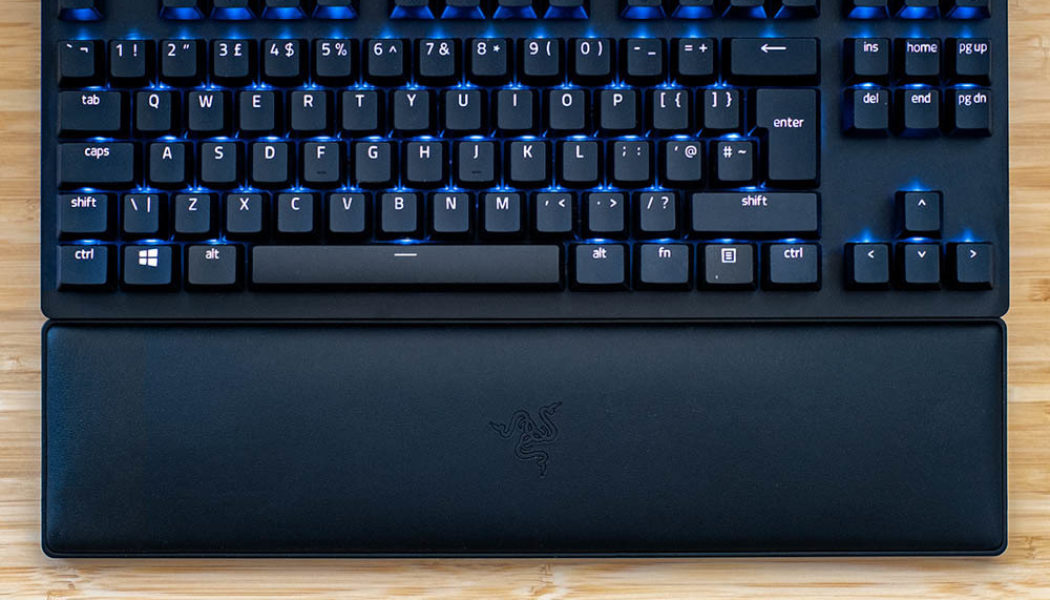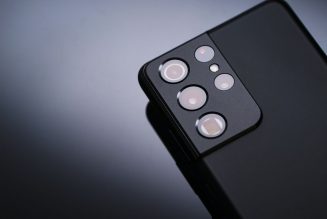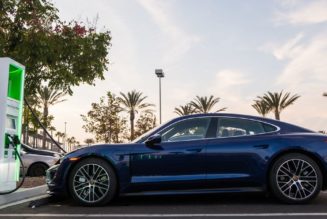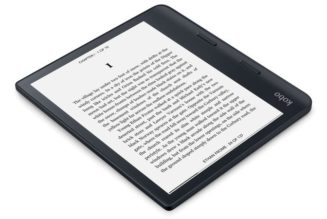Razer’s latest keyboard, the Huntsman V2, is all about speed. It’s equipped with optical mechanical switches that can theoretically register key presses far faster than their traditional mechanical counterparts. Then, its 8,000Hz polling rate means it can report that key press to your PC nearly instantaneously.
So yes, it’s theoretically very fast, arguably faster than most people will notice. But this speed doesn’t come at the expense of any other important elements of a modern mechanical keyboard. There’s RGB lighting support, software to customize the keyboard’s key maps and lighting effects, and — in the case of the full-size model — a volume wheel and dedicated media controls. But Razer has also made some choices with the linear switches in particular, that means that the Huntsman V2 might not be to every gamer’s tastes.
The new Huntsman V2 comes in at four different price points depending on whether you want a numpad, and whether you like your switches clicky or linear. The tenkeyless model starts at $149.99 with clicky switches, or $159.99 with linear, while the full-size model is $189.99 or $199.99. That’s relatively expensive by off-the-shelf mechanical keyboard standards, meaning the Huntsman V2 has a lot to prove.
I’ve been testing two of the variants for this review, a Razer Huntsman V2 with clicky switches and a Razer Huntsman V2 Tenkeyless (aka TKL) with linear switches, both with a UK layout (US is also available). The latter comes without a numpad, volume wheel, or media keys. But the core functionality of both keyboards are identical, including their switch options, polling rate, and construction, so it makes sense to talk about them as a pair.
I’ve never been much of a fan of Razer’s bright green and black gamer aesthetic, but I was pleasantly surprised with how understated Huntsman V2 keyboards are beneath their rainbow-colored RGB lighting, which is easily disabled in their settings. Both the TKL and the full-size models are plain black, and their keycaps use a nice neutral font for their lettering. Only the TKL model actually has any visible Razer branding, and even then it’s limited to a lettermark subtly printed above the arrow keys. On the full-size model, this space is taken up with indicator LEDs for things like caps lock.
This space-efficient design means that both keyboards are relatively compact considering their layouts. There’s no large forehead here like you’ll see on Corsair’s keyboards: the footprint of both Huntsman V2s is just a little bigger than the keyboard layouts they contain. Razer does include a wrist rest with both boards — a soft cushion of fake leather — which increases their footprint a little, but I think it’s a worthwhile addition. The USB cable is removable on the TKL and uses a standard Type-C connector on the keyboard end. It’s weirdly (and annoyingly) fixed in place on the full-size model.
:no_upscale()/cdn.vox-cdn.com/uploads/chorus_asset/file/22869984/jporter_210920_4765_0011.jpg)
The keycaps are made from relatively thin PBT plastic and use a double-shot design for their lettering, which allows their backlighting to shine through and should prove durable over time. All the keys here are standard sizes, so you shouldn’t have any problems finding aftermarket keycaps if you so choose.
The exception to this otherwise understated look is the keyboards’ RGB lighting, which by default cycles through a kaleidoscopic rainbow of colors. I far prefer an all-white color-scheme, and it was a simple matter of customizing this using Razer’s Synapse software. Using this software involves agreeing to Razer’s terms of service, but you can use it in guest mode if you’d rather not create a Razer account. Like Razer’s other products, this lighting can sync with various compatible games if you so choose. Its software also allows for the keyboard’s keys to be remapped, and for the most part it’ll remember these changes if you plug it into a different computer, although there are exceptions like lighting profile.
Neither keyboard feels flimsy with little to no flex, but they lack the weight and heft of keyboards like the Keychron Q1. I think that’s only likely to matter if you want a heavy keyboard for the sake of having a heavy keyboard.
Razer’s big selling point for the Huntsman V2 lineup, and its big upgrade over its predecessor, is its 8,000kHz polling rate, which means that the keyboard is checking for key presses and reporting them back to your computer 8,000 times a second. That’s eight times faster than the original Huntsman and most other keyboards.
:no_upscale()/cdn.vox-cdn.com/uploads/chorus_asset/file/22869982/jporter_210920_4765_0009.jpg)
:no_upscale()/cdn.vox-cdn.com/uploads/chorus_asset/file/22869981/jporter_210920_4765_0008.jpg)
We’ve seen other keyboards offer similarly high polling rates like Corsair’s K70 RGB TKL, but Razer’s Hunstman has a couple of theoretical advantages. First off, while Corsair’s recent keyboard reports over USB at 8,000Hz, it’s actually only internally scanning for key presses at 4,000Hz. In contrast, Razer tells me the Huntsman V2’s entire stack is 8,000Hz, which should give it a small advantage in responsiveness.
But more importantly, the Huntsman V2, like the Huntsman before it, uses optical mechanical switches. That means they use a small beam of light to detect when a key has been pressed, rather than using metallic contacts as with Cherry’s traditional MX switch design. This solves a problem with mechanical switches where the contacts can “bounce” together before making final contact. It’s something that only happens for a fraction of a second, but it means that traditional mechanical keyboards suffer from a “debounce delay” while they work out whether a keypress has actually happened. Optical switches don’t have this problem. So in the case of the Huntsman V2, you should be able to press a switch and have it report back to your machine with almost no latency, according to Razer.
That’s the theory, but while I wish I could say that I feel the difference, I struggled to notice it in practice. I played around 10 hours of Deathloop on the Huntsman V2 with my frame rate at a more or less stable 90fps and struggled to notice any improvements in latency compared with my usual 1,000Hz Filco Majestouch 2 keyboard. That’s not to say there wasn’t an objective difference in latency. Filming myself hitting the spacebar in Overwatch in slow-mo at 240fps with the game running at 100fps showed that the Huntsman V2 does indeed have a faster response time. It just wasn’t acute enough for me to feel in practice.
:no_upscale()/cdn.vox-cdn.com/uploads/chorus_asset/file/22869985/jporter_210920_4765_0012.jpg)
That said, these results will vary a lot depending on the kinds of games you play, and the frame rates they run at on your machine. So if you’re a fan of playing esports titles on a 240Hz or even 360Hz monitor, and have faster reflexes, then it could make more of a difference. But, for me, the difference was negligible. For most people, I don’t think the 8,000Hz refresh rate makes enough of a difference to warrant recommending the Huntsman V2 over an otherwise similarly specced competitor.
It’s at this point that I’d normally quickly outline the switch options of a keyboard and tell you to follow your heart: whether that be to smooth linear switches, bumpy tactiles, or clicky… clicky switches. But it’s not that simple with the Huntsman V2, which is available with either clicky or linear switch options.
Yes, both switches share a lot of the same fundamentals. They’re both optical, obviously, and both have stabilizer bars built into each and every switch, which Razer says is to cut down on the amount of moving parts. But the linear switches specifically have been updated since the original Huntsman, and now have a built in “silicon sound dampener.”
:no_upscale()/cdn.vox-cdn.com/uploads/chorus_asset/file/22869976/jporter_210920_4765_0004.jpg)
:no_upscale()/cdn.vox-cdn.com/uploads/chorus_asset/file/22869977/jporter_210920_4765_0005.jpg)
It means the two switch types feel radically different, far more so than you’d expect when comparing the clicky and linear options on another keyboard. And I don’t think the changes Razer has made with its second generation linear optical switches are necessarily an improvement.
That’s because this silicon sound dampener has a major impact on the way the linear switches feel. It’s similar to the effect you’d get by installing rubber O-rings on a normal mechanical switch, only built into their design with no option to remove them. Yes, this makes for a quieter keyboard, but it’s at the expense of that crispness that I’d argue is part of the fundamental appeal of mechanical keyboards in the first place. It feels like you’re typing on a membrane keyboard, just with the improved responsiveness and durability of a mechanical keyboard.
The clicky switches are better, but I still don’t think the typing experience is great. Although it’s not nearly as soft as the bottoming out feeling of the linear switches, there’s still a slight mushiness to the feeling here, and the keyboard’s stabilizers (the mechanisms under long keys that stop them from wobbling) have a bit of rattle to them. If you want a lovely crisp and clean-feeling typing experience, this isn’t it.
:no_upscale()/cdn.vox-cdn.com/uploads/chorus_asset/file/22869983/jporter_210920_4765_0010.jpg)
On paper, it’s hard to knock either the Huntsman V2 or the Huntsman V2 Tenkeyless. They’re responsive thanks to fast polling and optical switches, well supported with Razer’s software, and have designs that should work well on basically any desk. Each also has its own nice quality-of-life features, like a volume wheel on the full-size model and a detachable USB-C cable on the TKL version.
But I think the improvement in responsiveness is marginal at best and only really relevant if you’re playing an esports-focused title at higher refresh rates. Then, when it comes to the Huntsman V2’s overall typing experience, it simply can’t match up to other similarly priced keyboards available elsewhere. It’s a very functional keyboard, but it falls short of matching this functionality with quality.
Photography by Jon Porter / The Verge









